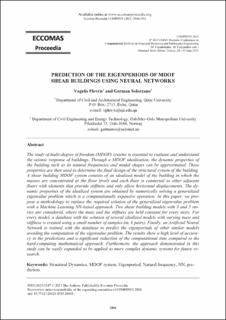| dc.contributor.author | Plevris, Vagelis | |
| dc.contributor.author | Ramirez, German Solorzano | |
| dc.date.accessioned | 2022-04-06T11:21:03Z | |
| dc.date.available | 2022-04-06T11:21:03Z | |
| dc.date.created | 2021-10-28T15:38:54Z | |
| dc.date.issued | 2021 | |
| dc.identifier.isbn | 978-618-85072-5-8 | |
| dc.identifier.issn | 2623-3347 | |
| dc.identifier.uri | https://hdl.handle.net/11250/2990190 | |
| dc.description.abstract | The study of multi-degree of freedom (MDOF) systems is essential to evaluate and understand the seismic response of buildings. Through a MDOF idealization, the dynamic properties of the building such as its natural frequencies and modal shapes can be approximated. These properties are then used to determine the final design of the structural system of the building. A shear building MDOF system consists of an idealized model of the building in which the masses are concentrated at the floor levels and each floor is connected to other adjacent floors with elements that provide stiffness and only allow horizontal displacements. The dynamic properties of the idealized system are obtained by numerically solving a generalized eigenvalue problem which is a computationally expensive operation. In this paper, we propose a methodology to replace the required solution of the generalized eigenvalue problem with a Machine Learning NN-based approach. Two shear building models with 3 and 5 stories are considered, where the mass and the stiffness are held constant for every story. For every model, a database with the solution of several idealized models with varying mass and stiffness is created using a small number of samples (m, k pairs). Finally, an Artificial Neural Network is trained with the database to predict the eigenperiods of other similar models avoiding the computation of the eigenvalue problem. The results show a high level of accuracy in the predictions and a significant reduction of the computational time compared to the hard-computing mathematical approach. Furthermore, the approach demonstrated in this study can be easily expanded to be applied to more complex dynamic systems for future research. | en_US |
| dc.language.iso | eng | en_US |
| dc.publisher | ECCOMAS | en_US |
| dc.relation.ispartof | Proceedings of the 8th International Conference on Computational Methods in Structural Dynamics and Earthquake Engineering | |
| dc.relation.ispartofseries | International Conference on Computational Methods in Structural Dynamics and Earthquake Engineering;8th International Conference on Computational Methods in Structural Dynamics and Earthquake Engineering | |
| dc.subject | Structural dynamics | en_US |
| dc.subject | MDOF systems | en_US |
| dc.subject | Eigenperiods | en_US |
| dc.subject | Natural frequency | en_US |
| dc.subject | Neural networks | en_US |
| dc.subject | Predictions | en_US |
| dc.title | Prediction of the Eigenperiods of MDOF Shear Buildings Using Neural Networks | en_US |
| dc.type | Conference object | en_US |
| dc.description.version | publishedVersion | en_US |
| dc.rights.holder | © 2021 The Authors | en_US |
| cristin.ispublished | true | |
| cristin.fulltext | original | |
| cristin.qualitycode | 1 | |
| dc.identifier.doi | https://doi.org/10.7712/120121.8755.20415 | |
| dc.identifier.cristin | 1949371 | |
| dc.source.journal | International Conference on Computational Methods in Structural Dynamics and Earthquake Engineering | en_US |
| dc.source.volume | 8 | en_US |
| dc.source.issue | 8 | en_US |
| dc.source.pagenumber | 3894-3910 | en_US |
